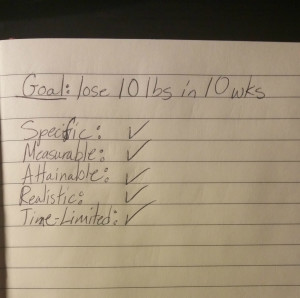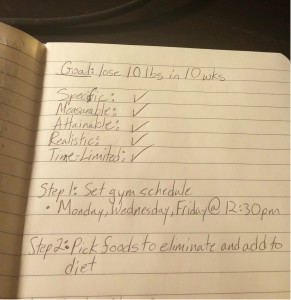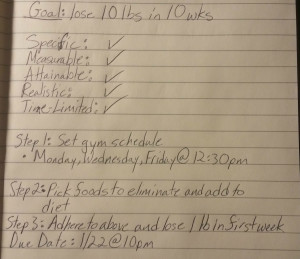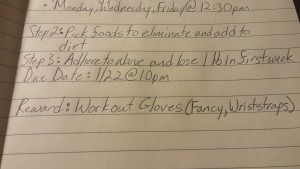The Foolproof Guide to Achieving Your Goals
Don’t have time to read this guide? Download it here.
Why You Need This Guide
Ever wonder why some people are far worse at achieving their goals than others?
I can tell you one big reason: poor goal-setting. Many of us were never taught the simple act of setting proper goals!
This guide aims to fix all of that.
The Problem
Here’s the deal: You can’t expect that you will have the drive to achieve some ambiguous goal, like losing weight or making more money, for very long.
Some goals are misleading because you think you are setting yourself up for success. In reality, if your goals are too vague, you’re essentially setting yourself up for failure.
What most people do is say, “My New Year’s Resolution is to lose some weight!” They get all excited, and for the first two-to-four weeks, they’re committed.
They throw out (or poorly hide) all the junk food, sign up for a gym membership, and get rocking!
Unfortunately, a few weeks into their mission, they go right back to their old habits, and the motivation to finish what they started slowly disappears.
Does that sound like someone you know?
The Solution
This pattern can be attributed to a bunch of different reasons, but the most common cause is the lack of structure and accountability surrounding the main objective. It can’t simply be an ambiguous, amorphous goal; your goals need to be S.M.A.R.T goals. S.M.A.R.T goals are:
– Specific: There is a specific action to take.
– Measurable: The goal provides a way to track your progress and the outcome.
– Attainable: It is actually possible to achieve the goal?
– Realistic/Relevant: It is realistic for you to achieve the goal because it is relevant to you?
– Time-Bound: Your goal is bound by a deadline.
Example
Let’s look at the very common New Year’s Resolution to lose weight. Examine this goal a bit deeper:
| Is it… | Answer | Comments |
| Specific? | Yes. | You stated you want to take a specific action: Losing weight. |
| Measurable? | No. | What constitutes “losing weight” to you? 1 pound? 5 pounds? 10? |
| Attainable? | Yes. | If you lose any amount of weight according to your goal, you will be successful. However, the question remains whether you will be satisfied with your success. |
| Realistic/Relevant? | Yes. | You can realistically lose weight as long as it is relevant to you. |
| Time-Bound? | No. | There is no deadline to hold yourself accountable to. |
Let’s instead transform this ambiguous goal into a S.M.A.R.T goal. Now, rather than losing weight, you want to lose 10 lbs in 10 weeks.
| Is it… | Answer | Comments |
| Specific? | Yes. | There is still a specific action to take. |
| Measurable? | Yes. | You can lose 1 pound per week to make the goal, and/or have a mid-goal checkpoint at 5 weeks to ensure you are on-track. |
| Attainable? | Yes. | Depending on your height, size, and body type, it is conceivably possible to accomplish this task. |
| Realistic/Relevant? | Yes. | You can realistically lose weight as long as it is relevant to you. |
| Time-Bound? | Yes. | You have 10 weeks to make it happen. |
You see the difference? S.M.A.R.T goals provide a well-defined and measurable way of making progress towards your goal, and progress motivates us to continue moving forward.
Case Study
Ever since I’ve heard of this S.M.A.R.T acronym, I’ve been weaving it into virtually every goal I’ve set for myself. Let’s take my upcoming book, for instance. I developed the urge to write a book about 3-4 years ago.
My goal was simply this: Write a book.
However, I had no idea how to get started and after a couple of weeks of flailing around trying to make my way, I eventually quit.
However, last February, I got the itch again. This time I was determined to finish this book by any means necessary. I went to an experienced book consultant who asked when I planned on finishing the book by.
Honestly, I had no idea how to gauge the time it takes to write a book, so I replied “Two years.”
She looked at me like I was crazy. “No,” she explained, “a more realistic goal would be to finish the first draft in 8 months.”
I gulped, and slowly said “Okay then…” I halfway thought she was crazy, too. But 8 months and two weeks later, I finished that book.
While I missed my deadline by a couple weeks, I finished something that others completely fail at. Honestly, without setting a S.M.A.R.T goal I probably would have completely failed at this book idea a second time.
My Foolproof Goal-Setting Process
S.M.A.R.T goals definitely provide you with something to take action on. However, there is still a bit more you can do to ensure you stay on track. Fortunately, I’m going to help you increase your chances of success in your goals dramatically by providing the proper frame and structure. I’ve broken down the process into the following 10 foolproof steps:
Step 1
Write down your goal using pen and paper.
This is important! Things stick more quickly when you physically write them down on paper instead of storing them virtually or in your head.
Step 2
Ensure it is a S.M.A.R.T (Specific, Measurable, Attainable, Realistic/Relevant, Time-Limited) goal.
Step 3
Write down the steps to achieve that goal. Think of all the methods that you will use to achieve your objective and the sequence that it will happen.
By this point, you have a battle plan to focus on and implement.
Step 4
At certain steps of the plan, set a milestone to accomplish.
Step 5
Set a reward that you get once you accomplish each milestone.
This is also very important! Celebrate in a way that is very controlled but rewards you for your hard work.
Step 6
Execute your plan, keeping regular notes of the progress.
Step 7
Adjust your plan if necessary to meet the goal.
Step 8
Celebrate your milestones once reached.
Oooh… fancy.
Step 9
Once you hit your new level of success, take some time to enjoy it and reflect before you set your next goal.
Treat yourself! You’ve earned it!
Step 10
Rinse, Repeat.
Does this method of goal-setting take some effort? Yes. Will it take time? Absolutely! However, if you are reading this, you are obviously not going to let a little hard work deter you from upping the chances that you will succeed in your endeavors!
What have you found that works best for you in terms of goal-setting? Enter your goal-setting strategies in the section below.
Also, if you want to save this post for later, I’ve got a PDF version you can download here.
Now let’s get to work on those goals!











Couldn’t agree more: making sure your goals are SMART is the only way to set them. Anything else and you can be sure to fail. That and also knowing why you want to achieve a given goal, because knowing the why will help you push through any obstacle.
Exactly! I know that’s right Michele… The “Why” is essential!
Great overview of SMART goals. Every month I take on a new 30 day challenge and every time I fail to make my goal specific and measurable, I fail. Every single time!
I know how that is. Clearly-defined, written-down goals are the best goals and offer you the highest chance of success.
Great post-Andrew. I think having a challenging but achievable time limit on our goals is the key. I tend to make my goals too hard to achieve by not giving myself enough time to complete them. I hope to start cutting myself some slack by setting more realistic time limits.
I do the same think Kimya. I hate that about myself but I always set high standards to meet or beat. The good thing is that I’m continually impressing myself with what I can do, but the bad thing is I am constantly under pressure as well. Setting the bar a bit lower isn’t such a bad thing for high performers, as long it isn’t TOO low.